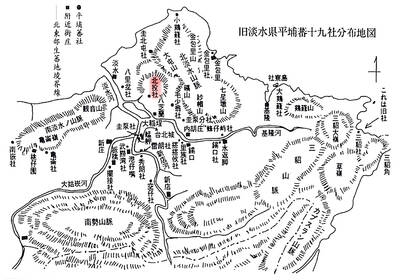The Tengger Desert lies on the southern edge of the massive Gobi Desert, not far from major cities like Beijing. The Tengger is growing.
For years, China’s deserts spread at an annual rate of more than 4,000km2. Many villages have been lost. Climate change and human activities have accelerated the desertification. China says government efforts to relocate residents, plant trees and limit herding have slowed or reversed desert growth in some areas. But the usefulness of those policies is debated by scientists, and deserts are expanding in critical regions.
BIG DESERT GETTING BIGGER

Photo: AFP
Nearly 20 percent of China is desert, and drought across northern China is getting worse. One recent estimate said China had 54,400km2 more desert than what existed in 1975 — about the size of Croatia. As the Tengger expands, it is merging with two other deserts to form a vast sea of sand that could become uninhabitable.
Across northern China, generations of families have made a living herding animals on the edge of the desert. Officials say that along with climate change, overgrazing is contributing to the desert’s growth. But some experiments suggest moderate grazing may actually mitigate the effects of climate change on grasslands, and China’s herder relocation policies could be undermining that.
In an area called Alxa League, the government has relocated about 30,000 people, who are called “ecological migrants,” because of desertification.

Photo: AFP
Officials have given Liu Jiali, 4, and her family a home in a village about 10km from Swan Lake, the oasis where they run a tourist park. To get them to move and sell off their herd of more than 70 sheep, 30 cows and eight camels, the officials have offered an annual subsidy equivalent to US$1,500 for each of her parents and US$1,200 for a grandmother who lives with them.
Jiali’s mother, Du Jinping, 45, said the family would live in the new village in the winter, but return to Swan Lake in the summer.
Local governments in desert regions began relocating people away from the encroaching sands decades ago. But China’s densely populated areas are pushing toward the deserts, as the deserts grow toward the cities.

Photo: AFP
Storms of wind-driven sand have become increasingly frequent and intense, reaching Beijing and other large cities. “We dread the sandstorms,” Du said.
Residents who live on the edge of the deserts try to limit the steady march of the sand. Along with local governments, they plant trees in an effort to block the wind and stabilize the soil.
Many people in this area are from families that fled Minqin, at the western end of the Tengger Desert, during China’s Great Famine from 1958-62, when tens of millions died.
Guo Kaiming, 40, a farmer who also manages a tourist park at the edge of the Tengger Desert, planted rows of trees by a new cross-desert highway in June.
Guo took saplings the government had left behind after it completed a tree planting operation. He said he was not ready to join the climate refugees. He has his corn and wheat fields, plus income from running the tourist park.
Last year, the company that runs the park paid students to build seven giant sand sculptures as its centerpiece. But strong desert winds steadily eroded them.
“They are all a mess now,” Guo said. “The wind is fierce.”
RECLAIMING THE DESERT
The government encourages farmers like Guo because, it says, agriculture can help reclaim land from the desert. Officials offer subsidies: Guo gets US$600 per year for “grassland ecological protection.”
But farming is also becoming more difficult. Huang Chunmei, who grew up in the town of Tonggunao’er and now farms there, said the water table was 2 meters below ground during her childhood, and “now, you have to dig 4 or 5 meters.”
Huang planted more than 200 trees on her own last spring, in the hope that they would help block sandstorms and hold back the sand.
“The soil is not as soft or good as it was before,” she said. “We use more fertilizer now.”
Huang and her husband have sent their 14-year-old daughter to a boarding school in a nearby city.
“I don’t want my girl to return,” she said. “The sand and wind make life tough here.”
About 17 percent of the population in Alxa League are ethnic Mongolians, whose lives and livelihoods have long been tied to the herding the government is trying to halt.
Mengkebuyin, 42, and his wife, Mandula, 41, grow corn and sunflowers, but their 200 sheep provide most of their income: They sell the meat to a hotel restaurant in a nearby city.
The sheep graze in the desert, where grass is growing scarce. They roam near his old family home, near the shores of a lake that dried up years ago. He would like to move to better pasture, but the government will not let him. Mengkebuyin and his wife maintain the old home but do not stay for long periods. They have moved to a village 5 miles away.
Mengkebuyin and Mandula have decided that they want their 16-year-old daughter to live and work in a city.
Four generations of Mengkebuyin’s family lived by the lake in a thriving community. But gradually, everyone left.
The desert has taken over.

Seven hundred job applications. One interview. Marco Mascaro arrived in Taiwan last year with a PhD in engineering physics and years of experience at a European research center. He thought his Gold Card would guarantee him a foothold in Taiwan’s job market. “It’s marketed as if Taiwan really needs you,” the 33-year-old Italian says. “The reality is that companies here don’t really need us.” The Employment Gold Card was designed to fix Taiwan’s labor shortage by offering foreign professionals a combined resident visa and open work permit valid for three years. But for many, like Mascaro, the welcome mat ends at the door. A

The Western media once again enthusiastically forwarded Beijing’s talking points on Japanese Prime Minister Sanae Takaichi’s comment two weeks ago that an attack by the People’s Republic of China (PRC) on Taiwan was an existential threat to Japan and would trigger Japanese military intervention in defense of Taiwan. The predictable reach for clickbait meant that a string of teachable moments was lost, “like tears in the rain.” Again. The Economist led the way, assigning the blame to the victim. “Takaichi Sanae was bound to rile China sooner rather than later,” the magazine asserted. It then explained: “Japan’s new prime minister is

Divadlo feels like your warm neighborhood slice of home — even if you’ve only ever spent a few days in Prague, like myself. A projector is screening retro animations by Czech director Karel Zeman, the shelves are lined with books and vinyl, and the owner will sit with you to share stories over a glass of pear brandy. The food is also fantastic, not just a new cultural experience but filled with nostalgia, recipes from home and laden with soul-warming carbs, perfect as the weather turns chilly. A Prague native, Kaio Picha has been in Taipei for 13 years and

NOV. 24 to NOV. 30 It wasn’t famine, disaster or war that drove the people of Soansai to flee their homeland, but a blanket-stealing demon. At least that’s how Poan Yu-pie (潘有秘), a resident of the Indigenous settlement of Kipatauw in what is today Taipei’s Beitou District (北投), told it to Japanese anthropologist Kanori Ino in 1897. Unable to sleep out of fear, the villagers built a raft large enough to fit everyone and set sail. They drifted for days before arriving at what is now Shenao Port (深奧) on Taiwan’s north coast,